Canon ELPH 520 HS / IXUS 500 HS review
-
-
Written by Ken McMahon
Intro
Announced in February 2012, The Canon ELPH 520 HS / IXUS 500 HS is a pocket super-zoom with a stabilised 12x optical range, 3in screen and sensor with 10.1 effective Megapixels. It’s not the top of the range ELPH / IXUS model, that title belongs to the ELPH 530 HS / IXUS 510 HS, identical in most respects but with a 16:9 touch-screen and built-in Wi-Fi. Between them, the ELPH 520 HS / IXUS 500 HS and ELPH 530 HS / IXUS 510 HS replace the 12.1 Megapixel touch-screen ELPH 510 HS / IXUS 1100 HS.
What you’re getting with the ELPH 520 HS / IXUS 500 HS is an impressively long zoom range in a very compact body packed with all of the consumer-friendly features that Canon is well-known for. These include Intelligent IS, Smart Auto mode with scene detection and a range of scene modes including Creative effects like Miniature and Toy camera.
Like all the 2012 ELPH / IXUS models the ELPH 520 HS / IXUS 500 HS supports 1080p24 HD video as well as two Super Slow Motion modes, the editing-friendly Apple iFrame movie format and the ability to use creative effects on movie footage. It has built in stereo mics and you can use the 12x optical zoom while shooting movies. In this review I’ve compared the ELPH 520 HS / IXUS 500 HS against the cheaper ELPH 110 HS / IXUS 125 HS. This may have less than half the zoom range, but it’s more affordable while also sharing the same core features as the rest of the 2012 ELPH / IXUS lineup. Read on to find out which provides the best balance of features, performance and price.
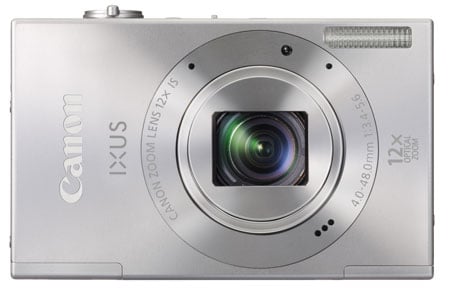 |
Canon ELPH 520 HS / IXUS 500 HS Design and controls
The ELPH 520 HS / IXUS 500 HS marks a move away from what I like to call the ‘choc ice’ styling of earlier ELPH / IXUS models and a return to the box shape of earlier generations. The metal body measures 87.1 x 53.9 x 19.2mm making it the smallest, slimmest ELPH / IXUS model, though at 155 grams it’s not the lightest. All the same it’s small enough to fit in the palm of your hand and is also a comfortable fit for your shirt pocket. The ELPH 520 HS / IXUS 500 HS is also a very stylish camera. The squared-off edges lend it a distinctive look that the range was in danger of losing.
With the exception of the shutter release, all of the buttons on the ELPH 520 HS / IXUS 500 HS are very small. They sit slightly proud of the camera surface but on the rear panel are quite close together so if you’ve got big digits it could be a problem for you. On the top panel the on/off button is joined by a dual-position auto/mode switch and the playback button. The rear panel lacks the usual four-way controller, replacing the disc pad with four individual buttons. The Func set button is placed below, rather than in the middle of the four, which takes a bit of getting used to; there’s also a menu button as well as a dedicated movie record button.
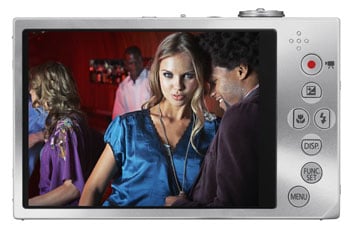 |
The ELPH 520 HS / IXUS 500 HS’s battery compartment is located on the bottom left corner of the camera. The NB-9L Lithium Ion Battery, which is about the same size and weight as an AA provides enough power on a full charge for around 190 shots which is comparitively poor, but marginally better than the 170 shots you get from the ELPH 110 HS / IXUS 125 HS.
The separate card compartment on the right front edge takes microSD, microSDHC and MicroSDXC cards. While this helps to keep down the overall size and weight of the camera, it does mean that unless you already own a device that uses the tiny memory cards, you’re going to have to buy at least one. The tripod bush is located on the right side of the base so while you can’t swap batteries with the camera on a tripod you can at least change cards. The ELPH 520 HS / IXUS 500 HS’s USB / A/V and mini HDMI ports are located under a flap on the right side of the body. You can connect it to a computer to download photos and movies and hook it up to either a standard or HD TV.
The buit-in flash has a claimed range of 2.5 metres at the wide angle lens setting. That’s on the low side for cameras in its class – the ELPH 110 HS / IXUS 125 HS goes to 3.5 metres and in practice I found that the illumination really does drop off rapidly beyond a couple of metres. Given its weak flash it’s just as well you have the choice of two optional add-on flash units – the HF-DC1 and HF-DC2.
Canon ELPH 520 HS / IXUS 500 HS lens and stabilisation
The ELPH 520 HS / IXUS 500 HS has a 12x optical zoom with an equivalent range of 28-336mm. That’s a really impressive range in such a compact body. It’s not quite as powerful as the 20x zoom of the PowerShot SX240 / SX260, but that’s a much bigger and heavier model as are other longer range super-zooms like the 18x Nikon S9300, 20x Sony HX20V and 16x Lumix ZS15 / TZ25.
The 12x zoom isn’t quite long enough for stadium sports or wildlife photography, but it can get you close in to action up to around a hundred metres distant. The f3.4 lens isn’t particularly bright and closes to f5.6 at the telephoto end of the range, so you also need good light to capture action shots at the faster shutter speeds.
If you’re used to comparing compact camera lens focal lengths and their 35mm equivalents (who isn’t?) you’ll notice that the ELPH 520 HS / IXUS 500 HS doesn’t have the same ‘crop factor’ as other compacts with a 1/2.3in sensor. For example the 4.3mm wide angle of the ELPH 110 HS / IXUS 125 HS translates to a 35mm equivalent of 24mm, yet the ELPH 520 HS / IXUS 500 HS has a 4mm wide angle which translates to a 28mm equivalent. The reason for this difference is that the ELPH 520 HS / IXUS 500 HS is fitted with a 16.8 Megapixel sensor, but only the central 10.1 Megapixel area is used for imaging.
Canon ELPH 520 HS / IXUS 500 HS coverage wide |
Canon ELPH 520 HS / IXUS 500 HS coverage tele | |
 | 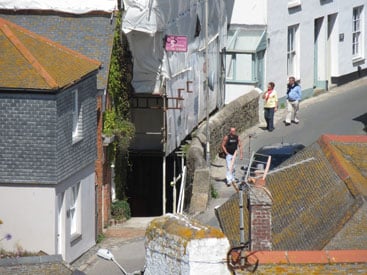 | |
| 4-48mm at 4mm (28mm equivalent) | 4-48mm at 48mm (336mm equivalent) |
Intelligent IS provides a claimed three and a half stops of stabilization suggesting you can shoot using shutter speeds of around 1/30th at the 336mm end of the zoom range. The camera automatically chooses one of seven stabiliser modes including the horizontal and vertical panning modes that you previously had to select manually. It also has a mode especially for macro shooting and can additionally tell when the camera is on a tripod and turns stabilisation off.
To test it, I zoomed the lens to 336mm and took a series of shots in Program Auto mode with IS in Continuous mode and turned off. The crops below show results from the ELPH 520 HS / IXUS 500 HS at 1/13th of a second, well in excess of the three and a half stops of claimed stabilisation and an impressive result. Just to put that in context, despite it’s small size, the ELPH 520 HS / IXUS 500 HS is an easy camera to hold steady and I was able to get good results without the stabilisation at well below the 1/300th or so that convention suggests is the minimum safe shutter speed.
Canon ELPH 520 HS / IXUS 500 HS Intelligent IS Off/Continuous | ||||
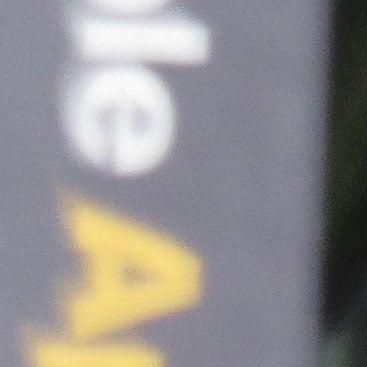 | 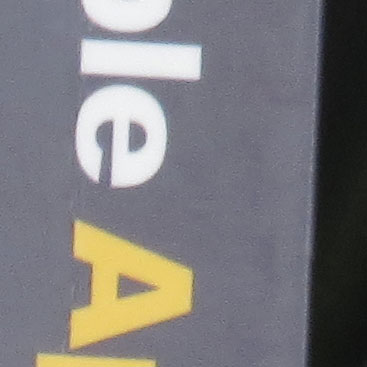 | |||
100% crop, 4-48mm at 48mm, 200 ISO 1/13th IS Off. | 100% crop, 4-48mm at 48mm, 200 ISO 1/13th IS Continuous. | |||
Canon ELPH 520 HS / IXUS 500 HS shooting modes
Though Canon has in the past experimented with manual modes on ELPH / IXUS models, the ELPH 520 HS / IXUS 500 HS is fully automatic in terms of exposure modes. A two way switch on the top panel is used to select either intelligent Auto mode with scene detection or one of a variety of alternatives chosen from the quick access Func menu. Program Auto offers most control with the ability to set white balance, ISO sensitivity, and colour rendition. You can also dial in plus or minus two stops of exposure compensation.
Beyond program auto on the shooting mode menu are a wide variety of scene modes including what used to be called ‘Creative effects’. Canon compacts lack the panoramic and 3D modes of Sony, Panasonic and Nikon models, instead Canon has ploughed its own furrow with modes like movie digest, which buffers a short video clip prior to each stills shot you take, then edits them all together into a movie of you day’s events. Other modes include Miniature, Soft Focus, Monochrome and Colour accent – a monochrome effect which retains a single hue.
| Canon ELPH 520 HS / IXUS 500 HS Creative Effects | ||
 |
 |
 |
Handheld NightScene is a stacking mode which combines three shots for a better quality low noise image in low light. There’s also smile shutter which uses Face detect to take photos automatically. The ELPH / IXUS range has offered most of these shooting modes for at least two generations now and it’s a little disappointing not to see something new from Canon, even if it’s not original. The simple panorama modes pioneered by Sony and now being adopted by others are something Canon has apparently decided to steer clear of. Given the success of intelligent Auto scene detection it would be good to see Canon drop scene modes like Portrait, Snow and the redundant Stitch Assist and introduce another innovative new shooting mode in the same mould as movie digest. Maybe next year.
Canon ELPH 520 HS / IXUS 500 HS movie modes
The ELPH 520 HS / IXUS 500 HS retains the 1080p24 best quality HD movie mode of last year’s ELPH / IXUS lineup and intelligent auto exposure mode with scene detection for movie shooting. In Program Auto mode you can also use exposure compensation for movies – something that wasn’t possible on the earlier touch-screen ELPH 510 HS / IXUS 1100 HS.
Movies are encoded using the efficient H.264 codec and stored as QuickTime .mov files. The maximum HD single clip recording time is 10 minutes or when the file size reaches 4GB and Canon recommends a Speed Class 6 or faster micro SD card. The ELPH 520 HS / IXUS 500 HS has built-in stereo mics and the ability to use the optical zoom during movie recording is now standard across the ELPH / IXUS range.
| |
|---|---|
|
I’m not overly impressed with the video stabiliation on the ELPH 520 HS / IXUS 500 HS. This panning clip was shot with IS set to Continuous and Power IS enabled, but the resuts are quite jumpy.
| |
|---|---|
|
Stabilisation was disabled for this outdoor tripod mounted panning shot. The exposure is good and the AF copes well during the zoom, occassionally losing the focus but regaining it quickly and confidently. You could hear the zoom motor on the previous clip, but with the background noise and wind in this clip it’s fairly inaudible.
| |
|---|---|
|
In this indoor low light panning shot the ELPH 520 HS / IXUS 500 HS responds dramatically to the changing lighting, but without stepping. Noise is noticeable and white balance is also a little variable.
| |
|---|---|
|
The ELPH 520 HS / IXUS 500 HS can shoot VGA video using some Creative Effects filters and also has a Super Slow Motion mode with two frame rates. This is the slower of the two which shoots 320×240 clips at 240fps and replays at 30fps, effectively slowing the action to one eighth speed.
Canon ELPH 520 HS / IXUS 500 HS
handling
The ELPH 520 HS / IXUS 500 HS is ready to take a shot a little over two seconds after you switch it on, unless you’re in a big hurry that’s fast enough, though not particularly swift. The two-speed zoom is very quiet and provides a good degree of control – much more than on the single speed ELPH 110 HS / IXUS 125 HS.
The dual-position mode switch is a good compromise between a full-on mode dial and menu selectable shooting modes. In fact, it’s not a compromise at all, most of the time being able to switch from intelligent Auto to Program Auto is all you need, for other occasions it’s really not too much bother to hit the Func button and select the mode you want from the menu.
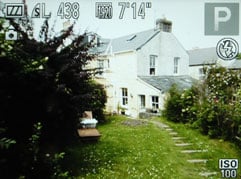 |
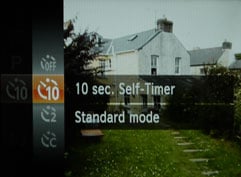 |
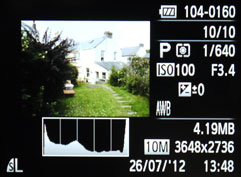 |
Generally, the AF performance on Canon compacts is fast and accurate, but the ELPH 520 HS / IXUS 500 HS feels a little sluggish. Even in bright sunlight there’s a perceptible delay before the Area AF locks on to the subject and with the lens fully zoomed in it takes even longer.
At 10.1 Megapixel resolution the ELPH 520 HS / IXUS 500 HS has a pedestrian continuous shooting speed of 2.8fps with the focus and exposure locked on the first frame. That increases to a claimed 6.1fps if you’re prepared to drop the image size to 2.5 Megapixels. It’s good to have the option of a faster reduced resolution burst mode, disappointing that the resolution has to be dropped so much. The ELPH 115 HS / IXUS 125 HS does a similar thing but maintains an (actual) rate of 4.8fps at 4 Megapixel resolution.
I tested the continuous shooting performance of the ELPH 520 HS / IXUS 500 HS using a Speed Class 6 micro SD card. With the shutter release held down for ten seconds the ELPH 520 HS / IXUS 500 HS shot at a consistent 5.9 frames per second.
The ELPH 520 HS / IXUS 500 HS has a back-illuminated CMOS sensor with an effective resolution of 10.1 megapixels. That figure literally doesn’t provide the whole picture though. The sensor is actually a 16.8 megapixel 1 / 2.3 inch sensor of which only the central 10.1 Megapixel area is used for imaging. This is probably the same sensor as in the ELPH 115 HS / IXUS 125 HS and ELPH 320 HS / IXUS 240 HS, which of course means that it will have the same pixel density as those models and the image quality and noise characteristics will be similar.
The ISO sensitivity range is 100 to 3200 ISO and the shutter speed range is 15 to 1/2000. Files are saved as JPEGs at one of two compression settings, the best quality Superfine setting produces images with an average file size of around 5.5 to 7.5MB.
To see how the quality of the ELPH 520 HS / IXUS 500 HS measures-up in practice, take a look at my Canon ELPH 520 / IXUS 500 quality and Canon ELPH 520 / IXUS 500 noise results pages, browse my Canon ELPH 520 / IXUS 500 sample images, or skip to the chase and head straight for my verdict.




